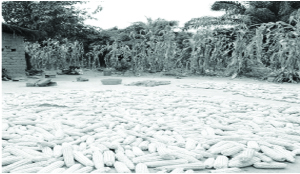By JAMES KUNDA –
FOR the past 50 years after gaining independence in 1964, Zambia has solely been dependent on maize as a staple food to feed its constantly growing population.
At independence, Zambia only had a population of only 3.6 million people across the 752,000 square kilometre of land.
Today, this country has more than 13 million inhabitants depending on not less than 3 million tonnes of maize produced by local farmers annually.
Maize production over the last few farming seasons had deteriorated to 2.7 million tonnes in 2013, owing to several factors such as late delivery of farming inputs and poor rainfall.
This has resulted into intermediate shortage of maize, especially between the months of December and April after when the new crop is harvested.
However, this is the time when the price of maize and subsequently mealie meal are adjusted upwardly.
Currently, millers are buying a tonne of maize at K1,700 from the Food Reserve Agency (FRA) along the line of rail and K1,600 per tonne elsewhere.
As at the end of December 2013, prices of mealie meal had skyrocketed from K65 to K75 per 25 kilogramme bag of breakfast and K45 per 25 kilogramme bag of roller meal.
The increase could also be attributed to the changes in market forces that saw the Government waive the production subsidy on maize and the subsidy on petroleum.
The policy to remove the subsidy on maize was necessitated by the mere fact that millers periodically increased the price of their commodity even when Government met a proportion of their production costs.
Removing the subsidy on fuel on the other hand has increased the cost of transportation for millers especially that milling facilities are located far off the rural population.
Maize at farm level is produced in bulk, and then transported to the urban areas with large milling plants for grinding into mealie meal.
The mealie meal is then transported back to the rural districts and constituencies for sale at a higher price to the same farmer who has kept the millers in business.
This trend is not right and Government should expedite the roll-out of milling plants across the country as a long-term measure to cushion the high price of mealie meal.
Similarly in the interim, Government should roll-out hammer mills in the rural areas so that the price of the commodity can be reasonable for the ordinary consumer.
The establishment of hammer mills will also avert intermittent shortages of mealie meal.
Government has secured over 400,000 tonnes of maize for the Strategic Grain Reserves (SGRs), to help mitigate any shortages of the commodity on the market over the next few months ahead.
From this, 50,000 tonnes of maize has been offloaded to the millers to increase production so that any mealie meal shortages are averted.
In enforcing the ban on exports of mealie meal, Government should on the other hand also halt the export of unprocessed maize so that local demand is satisfied to the fullest.
Currently, 205,000 tonnes of maize from last year’s harvest are earmarked for export to Malawi, Tanzania and Zimbabwe by the Food Reserve Agency (FRA).
Though this may leave Zambia with about 1one million tonnes of maize in reserve, the exercise should have been halted for now more so that the ongoing farming season has started on a low note with clear proof of a bumper maize harvest.
Another available option for Government is to overhaul the agriculture system in Zambia, so as to accommodate the growing of other crops besides from maize.
Depending on one staple crop for more than five decades is unsustainable and Zambia ought to change this status quo to enhance national food security.
Government has this year pledged to map out crop zones in selected parts of the country, to enable farmers grow crops which can grow well in certain environments.
Zambia can take a leaf from countries like Nigeria which has staple foods like yam, rice and others, feeding a population of more than 100 million people.
Here we have areas like Western and Northern provinces which are ideal for rice farming due to the availability of additional water bodies.
Crops such as rice, sweet potatoes, Irish potatoes and cassava, should be grown on large scale so that reliance on maize is reduced.
This will not only ensure household and national food security, but increase agriculture processing activities to grow the base of locally made products from crops.
There is an open opportunity for investors to create value for the rice produced in such areas more so that, seed is readily available to the small scale farmers.
Zambian Breweries (ZB) has already set the bench mark with an establishment of a processing plant to produce alcohol from cassava.
This could be done by also supporting out grower schemes at community level so that in view of agriculture processing facilities, productivity at farm level is maximised.
Government should however, ban the importation of foods such as rice because this country has the capacity to produce a surplus for local consumption and exports.
The more products the country imports, the more this country is robbed of value addition to wealth and job creation schemes in the agriculture processing sector.
In 2014, Government should set its focus on enhancing value addition so that more facilities are available to support small-scale crop production at grassroots level.
Further, there is also need to ensure that crop zones are set-out strategically to not support crop diversification, but also add value to agriculture produce from these blocs.







